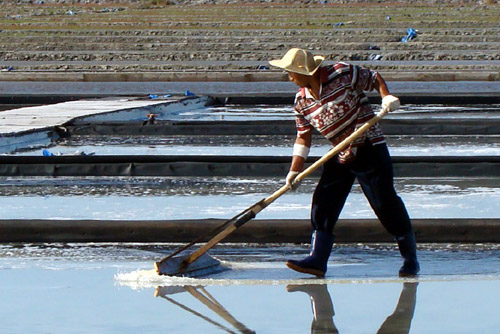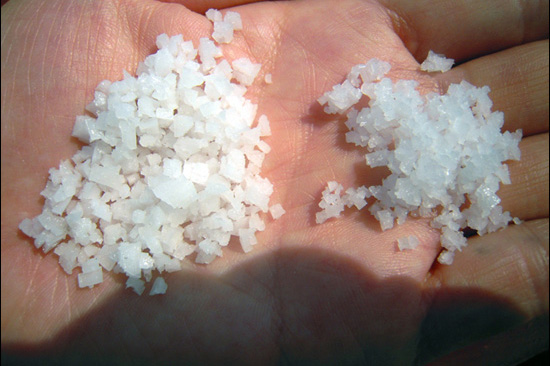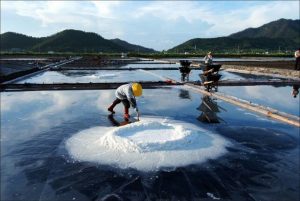A salt worker’s day follows the schedule of the sun. Salt workers get up before sunrise and start their day’s work by pushing away the water that has accumulated. By afternoon, all of the water has evaporated under the strong sunshine, leaving salt that blooms like flowers as crystals appear. At around 6 o’clock, the salt workers rake up the salt with heavy wooden rakes and put it into storage to give it time to rest. As the sun sets over the saltworks, the salt workers head for home, their weary rakes over their shoulders.
Between March and October, the hours of sunlight, height of the sun, temperature, humidity, and strength of the wind are ideal for saltmaking, so salt workers collect salt every day except when it rains, without respite. They cannot take a day off to relax from early spring to late fall. On mornings when it rains, they wake up in a panic. To those without much knowledge of salt making, a rainy day might seem like a day off for a salt worker; however, if they do not tend to the salt flats when it rains, salt workers have two days’ hard work ahead of them, preparing the salt flats again from scratch.
As with other modern food products, salt is no longer produced in the traditional way. Most salt is produced using electrolysis to separate sodium chloride from sea water. This salt is highly refined because the resulting sodium chloride contains almost no impurities, but many of the minerals that are beneficial for health are also removed in the process, resulting in a salt that is inferior to natural sea salt in terms of its nutritional qualities.
Approximately 20 years ago, a major change occurred when salt makers started using black mats, which absorb more of the sun’s energy and speed up the salt-making process. This method has drastically improved the efficiency of salt production by reducing the length of time it takes to collect salt. For some time after the introduction of black mats, the traditional method of harvesting salt directly on the soil of the tidal flats all but disappeared.
Producing grey salt (as salt produced using the traditional method is called) is much more labor-intensive than using black mats. The process of making grey salt starts by gathering soil on the mudflats which is full of naturally-occurring minerals and teeming with living organisms. Workers pile this soil about 5 cm thick to compensate for some of it being washed away, and then compress it with rollers. Rolling both vertically and horizontally, they compact the soil very tightly before it is exposed to rain or seawater. When they harvest the salt, they must use rakes that are even larger and heavier than those used in the black-mat process. When raking the salt, they must be very careful not to disturb the underlying soil on the mudflat. They must even be mindful of their footsteps so as not stir up the soil and thereby contaminate the salt. It is very difficult and laborious work.
The amount of grey salt produced is very small compared to amount of other kinds of salt. The process takes two to three times longer than using black mats, which absorb the heat of the sun and shorten the evaporation time so that the salt can be harvested in two days. Especially given the vagaries of the weather these days, it is not easy to produce grey salt because it normally requires four consecutive days of sunny weather. This is due to the fact that, when it rains, salt workers must repeat the process of filtering, concentrating, and evaporating. For this reason, 20% less salt can be harvested on a given area using traditional methods compared to using black mats.
Still, salt makers recognize the value of grey salt and the importance and merits of the traditional process, so there is growing interest in reviving the old methods. One of the world’s most sought-after salts, Fleur de sel, which is produced in the town of Guérande, France in very small batches using traditional methods, is loved among epicureans worldwide because it is less bitter and has a subtle sweetness in the aftertaste due to its high mineral content. But the mineral content of Korean sea salt has been recognized as being even higher than that of Guérande’s salt. Furthermore, several recent studies found that grey salt has less bitterness and a better taste than salt produced with black mats.
Salt is produced through the combination of salt water, sunlight, and the toil of salt workers. Not many people around the world are aware that Korea produces salt of the highest quality; even Koreans themselves are not aware of this. It is high time that Koreans discover this culinary treasure which is a gift from the sea and sun – a masterwork of artisans, who are themselves marked by sea and sun.
By Park Jeong-Hyun (Jungsikdang)

















Leave a Reply
Be the First to Comment!